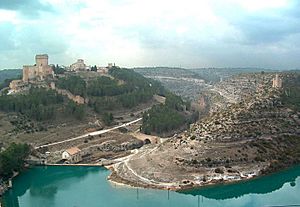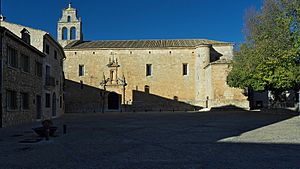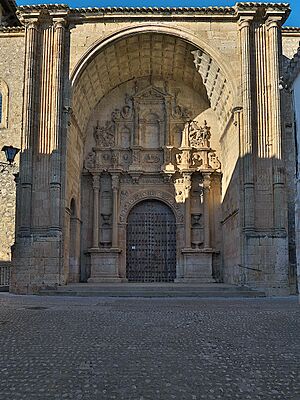Alarcón facts for kids
Quick facts for kids
Alarcón
|
|||
|---|---|---|---|

General view of Alarcón.
|
|||
|
|||
| Country | |||
| Autonomous community | |||
| Province | |||
| Comarca | La Manchuela | ||
| Area | |||
| • Total | 120 km2 (50 sq mi) | ||
| Elevation | 831 m (2,726 ft) | ||
| Population
(2018)
|
|||
| • Total | 153 | ||
| • Density | 1.28/km2 (3.30/sq mi) | ||
| Time zone | UTC+1 (CET) | ||
| • Summer (DST) | UTC+2 (CEST) | ||
| Bien de interés cultural | RI-53-0000247 as a Historic-Artistic Grouping since July 3, 1981 | ||
Alarcón is a small town in the Province of Cuenca, Spain. It is part of the Castile-La Mancha region. This historic town is famous for its amazing castle and beautiful old buildings.
Contents
Exploring Alarcón's Location
Alarcón is about 87 kilometers (54 miles) south of the city of Cuenca. It covers an area of 120 square kilometers (50 sq mi). The town sits on a high piece of land (a promontory) inside a curve of the Júcar River. This makes it a naturally strong place, almost like an island.
Near Alarcón, you'll find the large Alarcón Dam. This dam creates an important water storage area (a reservoir). There is also a smaller dam called Henchidero right next to the town.
Alarcón's Population Over Time
In 2013, Alarcón had a population of 159 people. This means there were about 1.3 people per square kilometer. The town's population has changed a lot over the years. It was much larger in the past.
| Demographic evolution of Alarcón (Spain) between 1842 and 2013 | ||||||||||||||||||||||||||||||||||||||||||||||||||||||||||||||
|---|---|---|---|---|---|---|---|---|---|---|---|---|---|---|---|---|---|---|---|---|---|---|---|---|---|---|---|---|---|---|---|---|---|---|---|---|---|---|---|---|---|---|---|---|---|---|---|---|---|---|---|---|---|---|---|---|---|---|---|---|---|---|
|
|
|
||||||||||||||||||||||||||||||||||||||||||||||||||||||||||||
Source:
|
||||||||||||||||||||||||||||||||||||||||||||||||||||||||||||||
A Look at Alarcón's Past
Alarcón has a long history, going back to the Iberians and Romans. It first became well-known when the Arabs took control. They built the first castle here, which the current one is based on.
The town's history is mostly about its role as a strong fortress. But Alarcón also has many other beautiful old buildings. These include several churches and important civil buildings.
In 1981, Alarcón was declared a "Historic-Artistic Grouping." This means it's a special place with important historical and artistic value.
In 1994, an artist named Jesús Mateo started painting inside the old Church of San Juan Bautista. These amazing paintings, finished in 2002, are known as the Mural Paintings of Alarcón. UNESCO recognized them in 1997 for their global artistic importance.
Famous People from Alarcón
- Juan de Alarcón (1395 – after 1451): An Augustinian writer who taught about the Bible.
- Juan Manuel, Prince of Villena: A famous author who wrote Tales of Count Lucanor. He once lived in Alarcón's castle.
- Jesús Mateo (born 1971): The Spanish painter who created the famous Mural Paintings of Alarcón.
Important Buildings and Monuments
The Castle of Alarcón
The Castle of Alarcón was first built by Muslims in the 8th century. King Alfonso VIII took it over in 1184. The castle sits on a high point inside a bend of the Júcar River. This made it a very strong fortress. From its walls, you can see amazing views towards Valencia.
The tallest part of the castle is the keep, built around 1460. The famous writer Juan Manuel, Prince of Villena, once lived here.
Over the years, the castle was repaired many times. In 1963, it became a Parador hotel, which is a special type of hotel in historic buildings. It opened as a hotel in 1966. Today, you can take tours of the castle with local guides.
Church of Santo Domingo de Silos
This church was built in the 13th century in the Romanesque style. Some parts of the original church are still there, like the rounded end (apse) and the southern entrance (portal). In the 16th century, a square tower and new walls were added in the Renaissance style. Later, the ceiling was changed during the Baroque period.
Today, this church is used as an exhibition hall and a place for performances. It was named a national monument in 1992.
Art Center: The Murals of Alarcón
The current Church of San Juan Bautista was built in the 16th century. It replaced an older Romanesque church. It has one main room (nave) and a special entrance in the Herrerian style. The tower is from the original church.
In 1995, artist Jesús Mateo started painting murals all over the inside of this old church. These incredible paintings were finished in 2002. UNESCO has supported this work since 1997. It is considered one of the most important examples of contemporary art in the world. More than 40,000 people visit it every year.
Church of the Santa Trinidad
This church has two main sections (naves), built in the 13th and 16th centuries. It has interesting pointed arches and a Renaissance altar. The entrance (portal) is in the Plateresque style. It shows the coats of arms of important historical figures. The church tower stands over an old town gate called the arco de la villa.
Church of Santa María del Campo
This building is currently used as the main church for the town. It was built in the early 16th century in the Plateresque style. The entrance was made around the mid-16th century by an artist named Esteban Jamete. He is also thought to have created the beautiful altarpiece that shows scenes from the life of the Virgin Mary.
Images for kids
See also
 In Spanish: Alarcón (España) para niños
In Spanish: Alarcón (España) para niños










